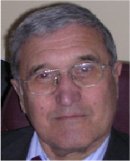|
Plenary
Lecture
On Thermal Equilibrium, Optimal Chemical Composition and
Residual Stresses during Quenching of Steels

Dr. Nikolai Kobasko
IQ Technologies Inc, Akron
USA and Intensive Technologies Ltd
Kyiv, Ukraine
E-mail:
nikobasko@yahoo.com
Abstract:
Hardening of steel is very important technology when
alloy elements are dissolved in austenite during
equilibrium establishment at high temperatures (800 –
1000oC). Then steel parts are rapidly cooled by water,
water jets, oils, polymers and other liquids to room
temperature where again new thermal equilibrium is
established. When hardened through, often cracks are
appearing due to tensile residual tresses are formed at
the surface. To prevent crack formation, slow cooling in
oils is widely used. During slow cooling material is not
enough strengthened, that is why more alloy elements are
added to the steel to provide needed strengthening. In
the plenary lecture principally new approach of steel
hardening is proposed. It is based on generalized
equation for cooling time evaluation which allows
calculating time of transition from high temperature
equilibrium to room temperature equilibrium. The
equation also calculates appropriate interruption time
to provide optimal quenched layer. Using the generalized
equation and CCT diagrams, the method for optimizing
chemical composition of steels is developed to obtain
optimal residual stress distribution throughout the
section of steel part. The advantage of this method
consists in the opportunity to use plain carbon steels
instead of expensive alloy steels and calculate ideal
critical size for a big variety of geometries on the
basis of using respective CCT diagrams which are used at
optimizing chemical composition of steels. It is
discussed in detail optimal depth of hardened layer
which provides high compressive residual stresses at the
surface and not big residual tensile stresses in the
core. Simultaneously during intensive quenching, the
superstrengthening of a material in outer layers is
occur. The method allows developing the new technologies
to save materials, increase service life of steel parts,
and use environmentally friendly liquids, just plain
water, as a quenchant. The service life of steel parts
increases due to high compressive residual stresses at
the surface and improved mechanical properties. Taking
all of these facts into account, a new approach for
hardening of steel parts in the heat treating industry
has been developed and applied into the practice.
Brief Biography of the Speaker:
Dr. Nikolai Kobasko received his PhD from the National
Academy of Sciences of Ukraine in 1969. He is a leading
expert on quenching and heat transfer during the
hardening of steels. He is the author and co-author of
more than 250 scientific and technical papers, several
books and brochures, and more than 30 patents and
certificates. In 2004, Dr. Nikolai Kobasko received the
Da Vinci Diamond Award and Certificate in recognition of
an outstanding contribution to thermal science. Dr.
Nikolai Kobasko is Co-Editor of the WSEAS TRANSACTIONS
on HEAT and MASS TRANSFER and is a member of Editorial
Board for International Journal of Mechanics (NAUN) and
Journal of ASTM International (JAI). He was the Head of
the laboratory of the Thermal Physics Institute of the
National Academy of Sciences of Ukraine. He is
co-founder of two consulting companies: IQ Technologies
Inc. Akron, USA (1999) and Intensive Technologies Ltd,
Kiev, Ukraine (2000). The aim of both companies is
material savings, ecological problems solving and
increaing service life of steel parts. In 2009 for
substantial and innovative contributions to thermal
science and heat treating technologies, including
development of novel quenching methods and application
of computational models to thermal processes Dr. Nikolai
Kobasko was elected as ASM International Fellow (FASM).
At present he is the Director of Technology and R&D of
IQ Technologies Inc., Akron, USA and also President of
the Intensive Technologies Ltd., Kiev, Ukraine. More
information is provided in http://www.intensivequench.com
and http://www.itl.kiev.ua.
|
